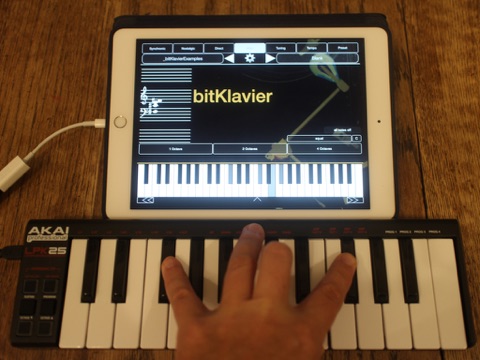
bitKlavier app for iPhone and iPad
Developer: Dan Trueman
First release : 03 Oct 2015
App size: 1.42 Gb
“The études, some fast and virtuosic, others spare and introspective, unfolded to beautiful and haunting effect in a haze of pitch-bending, echoes, distorted rhythms and eerie timbres.”
—The New York Times, about the Nostalgic Synchronic Etudes, made with bitKlavier
bitKlavier is the software that drives the "prepared digital piano;" it has been used by a number of composers for creating new music, and has been featured in performances around the world.
Like the prepared piano, the "prepared digital piano" feels just like a piano under the hands and often sounds like one, but it is full of surprises; instead of bolts and screws stuck between the piano strings, virtual machines of various sorts adorn the virtual strings of the digital piano, transforming it into an instrument that pushes back, sometimes like a metronome, other times like a recording played backwards. The virtual strings also tighten and loosen on the fly, dynamically tuning in response to what is played.
To begin, load a sample set ("lite" will load quickly and on older iPads, "medium" sounds better, but takes longer to load) and experiment with the included presets, many of which are from existing pieces (the Nostalgic Synchronic Etudes by Dan Trueman, and the Mikroetudes, a collection of small pieces by various composers), others are examples for exploring the various types of digital preparations. Work with the on-screen keyboards, or hook up a USB-MIDI keyboard using a Lighting-USB adaptor and play with a full-sized keyboard.
There are a range of "preparations," including:
1. Synchronic: "metronomes" of various sorts that respond to your playing.
2. Nostalgic: reverse piano, synced to the synchronic preparations or driven by the length of the notes that you play.
3. Tuning: various tuning systems, including some that change under your hands as you play.
4. Direct: muted notes, so they dont sound when you play, but their preparations activate; surprisingly useful!
These preparations can change under your hands in various ways. For instance, in the Tempo pane you can make the Synchronic metronomes follow the tempo of your own playing, and in the Preset pane you can make specific notes completely change the preparations to a different preset.
In each pane, there are "?" help windows that explain all of the parameters. Work with existing presets to create new ones and see where they take you. Save your new presets, create new libraries of presets, save them to Dropbox to share with others or to use with the OSX version, or load in libraries that have been created elsewhere.
See this set of short tutorials to get started: https://www.youtube.com/playlist?list=PLfxM062qDjMOQPQGbPQ829h6m24ZKDgmL



